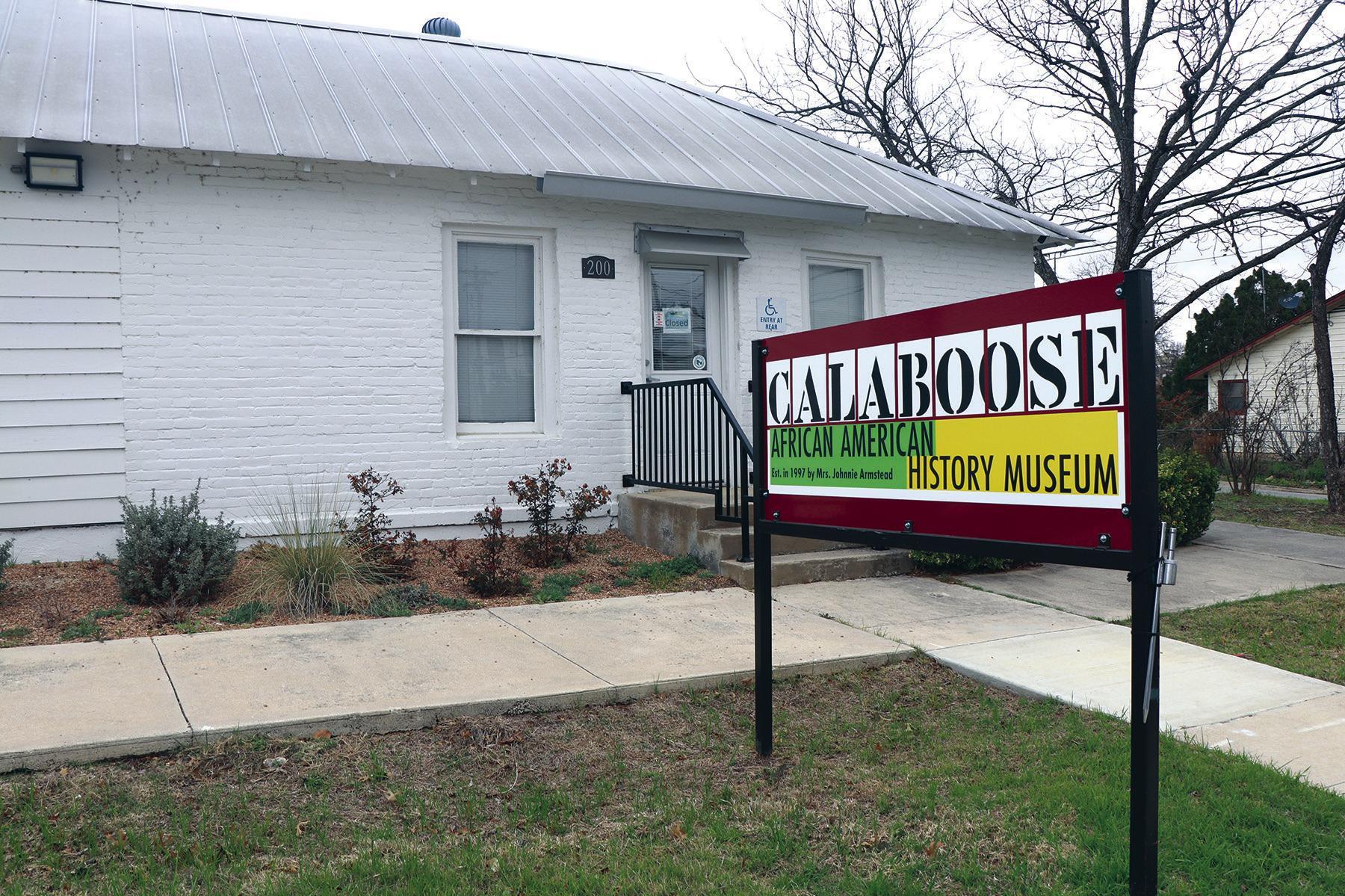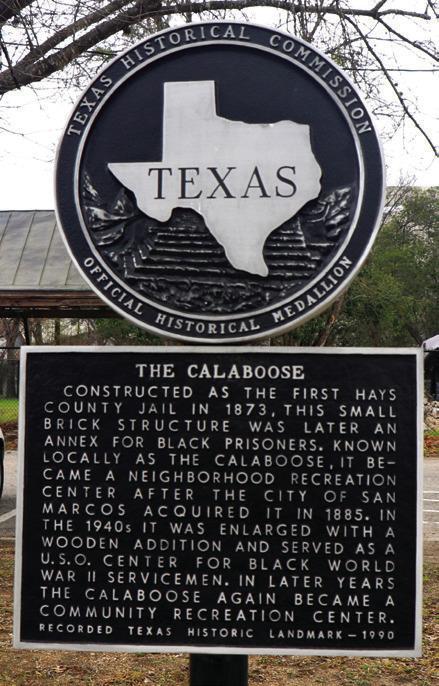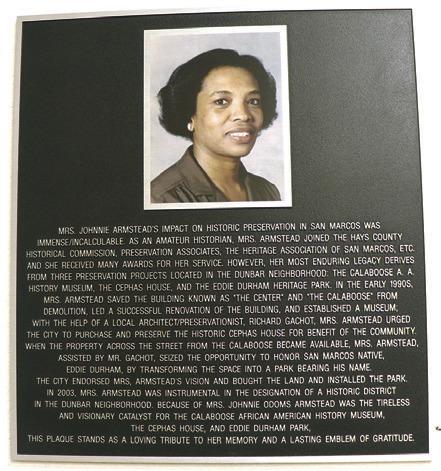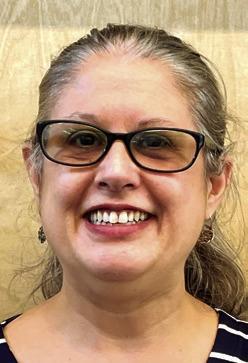
The Calaboose Museum was founded by Johnnie Armstead, who saved the building from demolition in 1997. Armstead became the driving force for its dedication as a museum.
Photo by Celeste Cook


Left, the Calaboose historical marker, and above, a plaque dedicated to Johnnie Armstead.

San Marcos Public Library 625 E. Hopkins St.
512-393-8200
Answers to Go
Q. What is the Calaboose Museum? Is it worth going to? What is its history?
A. The Calaboose African American History Museum, located at 200 West Martin Luther King Drive in San Marcos, is absolutely worth seeing. It has twice been named the Best of Hays winner in the Best Museum category and, as the “Austin Chronicle” said in a June 2003 article, the museum not only “seeks to reveal and establish so much previously overlooked history, but also to illustrate the importance of taking history seriously as it happens.”
The mission of the Calaboose is as follows:
The Calaboose Museum serves as a home for African American history and culture in San Marcos and Hays County. Through preservation, events and education, the museum strives to serve as not only an African American history museum but a center of support for the San Marcos community. (Calaboose)
Much of the information on the history of the Calaboose in this column was provided by Dr. Elvin Holt, archivist for the Calaboose African American History Museum. He has provided the library with a detailed account of the history of the structures that originally stood on the same property at the current museum. While I am providing just a summary of this information, the full document may be accessed through the library’s online catalog and paper files.
The word “calaboose” is a term derived from the Spanish word cal-abozo, meaning “jail” or “place of confinement.” Initially, a small wooden municipal jail, or calaboose, existed on the same property that two subsequent jails would be built.
In 1873, a two-story stone jail was built by the county and in 1884, the condition of that 1873 jail was so poor that plans were made to replace it. Thus, the city issued bonds to construct another two-story stone jail on lot 15, adjacent to the old 1873 jail. In 1885, Hays County proposed that the town of San Marcos purchase the old, vacant 1873 jail and grounds. As part of this arrangement, the city would give the county the wooden calaboose now on the jail grounds, valued at about $125 to be used as a cook house for the jail. Subsequently, the jails were often referred to as the “calaboose.”
The 1873 jail was demolished in August 1912 and a new city “lockup” was constructed. The 1922 Sanborn map (used for fire insurance purposes) shows a new one-story structure of brick. The site location, material and scale of the new San Marcos Calaboose on the 1922 Sanborn map is consistent with the eastern half of the present-day Calaboose Museum. Newspaper references indicate that this small jail was the city jail, and no contemporary references have been located suggesting that the jail was used exclusively for African Americans. However, in practice, the incarceration levels of African Americans and Mexicans were disproportionately higher than for those of other ethnicities.
In 1943, when the U.S. Army began moving soldiers to the Air Corps Navigation School (later known as Camp Gary), USO services were necessary to support the 16,000 troops that flooded San Marcos. A wooden extension was added to the Calaboose’s original structure at that time to make it large enough to function as a meeting place. It was named “The Negro Club” and was an extension of the San Marcos USO Club.
After the war, the building was used as a neighborhood meeting place and used for city functions. It was renovated several times and in 1990, it was renovated for use as “another public building” (Calaboose dedication). In 1997, “Mrs. Johnnie M. Armstead rescued the building from the wrecker’s ball and helped raise funds for its renovation under the direction of architect Jeffrey H. Kester. In May of 1997, the San Marcos City Council approved a resolution to designate the building for use as a history museum.” (Calaboose) Johnnie Armstead was a driving force behind the creation and dedication of the Calaboose as a museum. For years, she “collected everything she could find from garage sales, dumps, attics, and old barns — anything that shed light on a part of life in San Marcos and Hays County that was in danger of being forgotten… The Calaboose is not just a collection of grocery tickets, rusted tools, newspaper clippings and the like. It’s a testament to Armstead’s insistence that a lively community not be dismissed or forgotten.” (Lowery).
The Calaboose Museum maintains a permanent gallery and a rotating gallery. In the permanent gallery, you will see exhibit artifacts textiles, tools, documents, photos, books, etc. associated with prominent local African Americans such as John M. Tolliver, Ulysses Cephas, Antony Giles, Victoria Herring Wilson, Ollie Hamilton, Katherine Steen Hardeman, William “Doc” Burleson, Lucious Jackson and Eddie Durham, etc. The rotating exhibition focuses on specific aspects of African American history and culture. Generally, a new rotating exhibition is installed every three months. The current rotating exhibition, “Reflections on Black History and Culture: Story Quilts from the African American Quilters Circle,” features the work of professional art quilters from San Antonio. This rotating exhibition closes on March 31.
If you are not able to visit the Calaboose in person, you can visit the museum online at calaboosemuseum.org/ where under the Educational Enrichment heading (top of the web page) you will find a number of informational and engaging videos produced by the Calaboose.
The Calaboose is open Saturdays 10 a.m. – 3 p.m. or by appointment. To request a tour, visit the website, email info@calaboosemuseum.org or call at 512-393-8421.
• Calaboose dedication scheduled. (1990). “San Marcos Daily Record,” November 23, 1990, p. 4–4.
• Calaboose African American History Museum: San Marcos,Texas. Calaboose. (n.d.). Retrieved Jan. 29 from calaboosemuseum. org/
• Lowery, D. (2007). “Above and Beyond Keeping a Community Alive” (Johnnie Armstead). “Austin American Statesman.”
Suzanne Sanders is the columnist for the library. She is the Community Services Manager for the San Marcos Public Library and came from the Austin Public Library in 2015 after having served there as a librarian for over 20 years. She gratefully accepts your questions for this column.











